Introduction and summary
As the 2018 midterm elections approach, voters face important decisions about the issues and priorities they would like to see political leaders and governments at all levels address. Although less examined in relation to other major priorities such as health care or education, issues surrounding the availability and affordability of high-quality child care, and expanded early childhood education options, are fast becoming important political topics in public discourse and within political institutions.
Despite the rising importance of these issues, gaps remain in our understanding of how the public views the challenges and potential solutions for addressing child care and early learning. How are working parents today handling child care needs? Do they have good options for high-quality child care? Is child care affordable for these parents? Does the availability of child care influence personal decisions about work, including the types of jobs considered, hours worked, or responsibilities desired? Do parents want public school to start earlier for children, at the prekindergarten level? What role if any should governments play in providing assistance with affordable child care and expanded early childhood education? Will political leaders and institutions be rewarded for taking on these issues or punished for ignoring them?
Survey details
This study surveyed opinions among 1,657 registered voters nationally using an online panel and voter registration lists. The survey, conducted from June 18 to 26, 2018, includes a subsample of 484 parents whose children were under age 18 and oversamples of African American and Hispanic women to allow for better comparative analysis. The survey is weighted to reflect available national demographic data on registered voters. We simultaneously fielded separate surveys in Georgia, Minnesota, Nevada, New Mexico, and Ohio. This report presents the findings from the national survey in order to see how these issues are playing out across all parts of the country with numerous types of voters. The full results of the survey are on file with the authors.
To examine these and other related matters, early this summer, the Center for American Progress, the Center for Community Change, and Make It Work collaborated with GBA Strategies to design and field a comprehensive national survey of voter attitudes. Overall, this study finds that parents today face significant challenges finding quality, affordable child care for their families. This in turn affects the work and life decisions these families must make to compensate for difficult or expensive child care arrangements. Subsequently, voters across the board—particularly parents of younger children and mothers in general—strongly desire increased congressional and state action to address the crisis of affordable child care and to expand early education options. Voters at all stages of life, and across political lines, overwhelmingly back specific proposals to provide sliding-scale support for working parents to help afford good child care, to increase standards and oversight in child care facilities, and to improve the professionalization and pay of child care workers. By large margins, voters also report that they are more likely to back candidates for office who support and take steps to increase funding for these and other proposals.
The remainder of this report explores public opinion on these issues and presents clear evidence of the public’s desire for governments at all levels to do more to address the affordability of child care and ensure that all children have access to high-quality early childhood education options.
Families face hurdles finding quality, affordable child care arrangements
The study first explored the overall child care landscape facing voters to determine the extent of potential challenges. The survey asked respondents generally, “How serious of a problem is finding quality, affordable child care in your area?” As seen in Figure 1, 54 percent of voters overall report that finding quality, affordable child care is a “very serious” or “somewhat serious” problem in their area. Among parents, awareness of the challenge is far more acute. Seventy-one percent of parents of children under age 18 say it is a problem to find quality, affordable child care in their area, and more than 8 in 10 parents—83 percent—with children under age 5 say it is a problem. Around 7 in 10 African American women, 18- to 29-year-olds, and 30- to 39-year-olds, respectively, also report serious problems on this front.
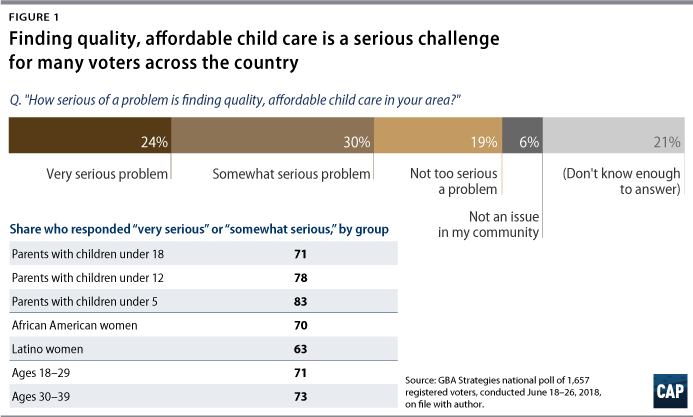
Among the subset of parents with children under age 18, we asked a follow-up question to assess the personal challenges they may face: “In your experience, has finding quality, affordable child care that’s convenient for your family been very easy, somewhat easy, somewhat difficult, very difficult, or have you not needed child care?” A plurality of parents overall, 47 percent, say that it has been “somewhat difficult” or “very difficult” to find convenient child care. This number climbs to 63 percent among parents of children under age 5. We find noticeable differences in responses to this question based on the level of parental education. A majority of college-educated parents—51 percent—say that it has been “somewhat easy” or “very easy” to find convenient child care, while a roughly similar proportion—52 percent—of noncollege-educated parents report that has been difficult finding quality, affordable care that is convenient for their families.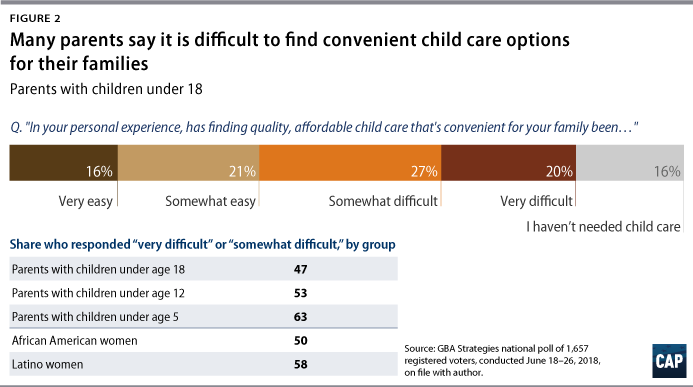
In terms of the career and financial impacts of child care on workers and families, the study asked voters whether they have, or someone in their family has, had their career or career prospects negatively affected—“such as passing up a job promotion, working fewer hours, or not being able to pursue new skills”—due to child care considerations.
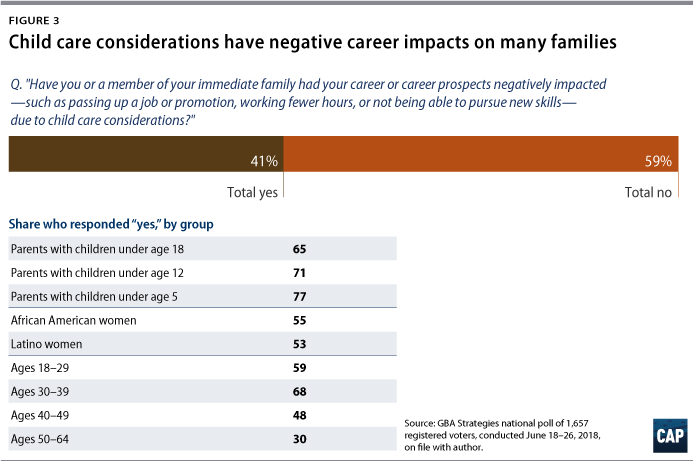
Although only 41 percent of voters overall report someone in their family experiencing negative career impacts due to child care issues, 65 percent of parents with children under age 18, 71 percent of parents with children under age 12, and 77 percent of parents with children under age 5 report negative impacts. Voters in the 30- to 39-year age bracket—prime child-rearing and career-building years—emerge as the hardest hit on the employment front, with 68 percent reporting negative work impacts from child care considerations. Perceived negative impacts drop as people age.

Given the sense among many parents that child care issues may be adversely affecting their earning and job promotion potential, it is interesting to see what exactly parents may do differently if child care costs and convenience were not such a challenge. As highlighted in Figure 4, 39 percent of parents say they would “look for a higher-paying job” if they or their children’s other parent had more reliable and affordable child care arrangements; 31 percent would “ask for more hours at work”; and 30 percent say they would “seek additional education or training” for their career.
Clearly, many parents today believe they could substantially improve their earnings or career preparation opportunities with child care options that better met their needs and their family budgets.
Voters want the government to be more involved in ensuring all families have quality, affordable child care and early learning options
Having established the significant challenges many families face on the child care front, the question remains whether voters view these issues as responsibilities for government. The short answer is: Yes, voters strongly believe the government should play a role in helping families get quality and affordable child care. The study presented two different opinions about the role of government in this area and asked voters which perspective comes closer to their own views, even if neither one is exactly right. Sixty-eight percent of voters overall say that, “Our public policies should be designed to help families afford the costs of child care and early learning” comes closer to their view, compared with 32 percent who believe the opposite, “Helping people afford child care or early learning is not the role of government.”
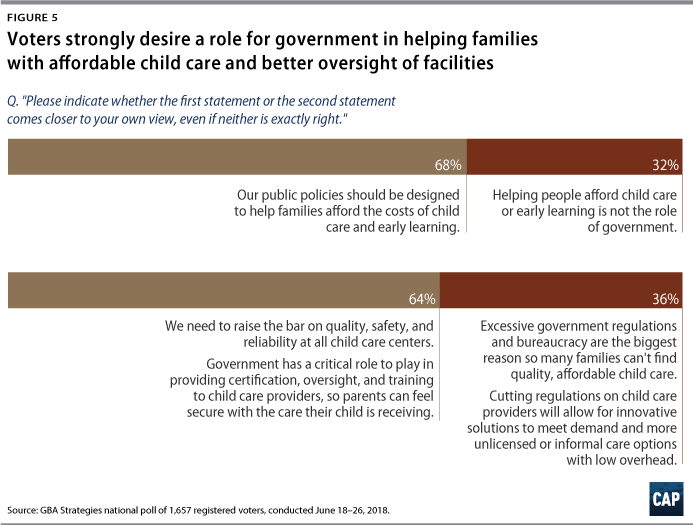
As might be expected, parents express higher levels of agreement with a role for government in child care and early learning, with more than three-quarters of parents of children under age 5 agreeing more with this first statement. Notably, support for public policies that help families afford child care crosses partisan lines, with majorities of Democrats (80 percent), independents (65 percent), and Republicans (56 percent) favoring a role for government in these areas.
Likewise, in a separate statement-pair test about government oversight, 64 percent of voters agree more with the idea that, “We need to raise the bar on quality, safety, and reliability at all child care centers. Government has a critical role to play in providing certification, oversight, and training to child care providers, so parents can feel secure with the care their child is receiving.” Thirty-six percent agree more with the notion that, “Excessive government regulations and bureaucracy are the biggest reason so many families can’t find quality, affordable child care. Cutting regulations on child care providers will allow for innovative solutions to meet demand and more unlicensed or informal care options with low overhead.” Again, cross-partisan majorities of voters favor increased government certification and oversight over less regulation, including 74 percent of Democrats, 63 percent of independents, and 54 percent of Republicans.
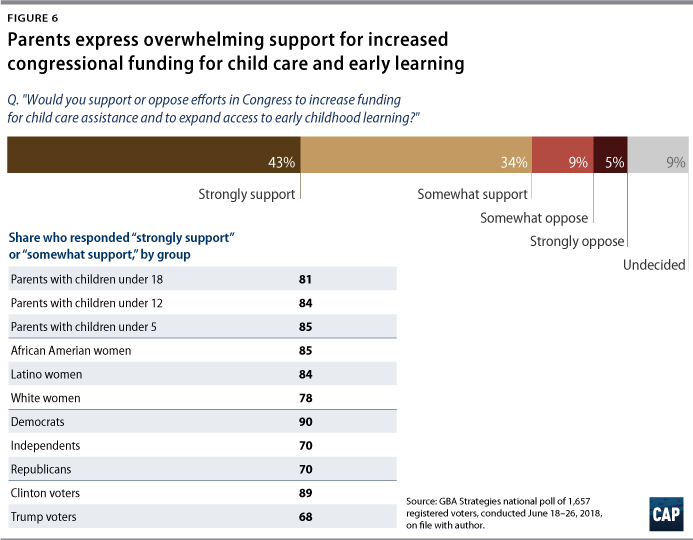 Complementing the broad desire for an increased role for government in the area of child care and early learning, the study finds remarkably strong levels of support for increased congressional funding for these policy areas. The survey asked respondents, “Would you support or oppose efforts in Congress to increase funding for child care assistance and to expand access to early childhood learning?” By a 77 percent-to-14 percent margin, voters overall favor increased funding for child care and early learning, with support crossing all demographic and partisan lines. More than 80 percent of parents back increased congressional funding in these areas, as do 90 percent of Democrats, 70 percent of independents, and 70 percent of Republicans. Eighty-five percent of African American women, 84 percent of Latinas, and 78 percent of white women support higher funding for child care, while 89 percent of Hillary Clinton’s voters from 2016 and 68 percent of Donald Trump’s voters from 2016 also support increased funding.
Complementing the broad desire for an increased role for government in the area of child care and early learning, the study finds remarkably strong levels of support for increased congressional funding for these policy areas. The survey asked respondents, “Would you support or oppose efforts in Congress to increase funding for child care assistance and to expand access to early childhood learning?” By a 77 percent-to-14 percent margin, voters overall favor increased funding for child care and early learning, with support crossing all demographic and partisan lines. More than 80 percent of parents back increased congressional funding in these areas, as do 90 percent of Democrats, 70 percent of independents, and 70 percent of Republicans. Eighty-five percent of African American women, 84 percent of Latinas, and 78 percent of white women support higher funding for child care, while 89 percent of Hillary Clinton’s voters from 2016 and 68 percent of Donald Trump’s voters from 2016 also support increased funding.
In follow-up questions to ascertain why voters either support or oppose increased congressional funding, the large group of supporters overwhelmingly cite the idea that “quality child care is too expensive for low-income and middle-class families” as their top reason for supporting the proposal, while the smaller group of opponents cite the idea that “it is the responsibility of parents, not government, to determine care for their children” as their primary reason for opposing these efforts.
Moving on to more specific policy proposals, the study finds even stronger evidence of public support for government actions to improve quality and increase access to affordable child care and early learning. As seen in Figure 7, proposals centered on the quality and professionalization of the child care and early learning workforce garner nearly unanimous support among voters; there is also exceptionally high support for proposals to subsidize child care on a sliding scale based on income.

More than 9 in 10 voters overall—92 percent—support a proposal to “set standards to improve quality and safety in child care programs,” while 90 percent back a proposal to “ensure people who work in child care earn a living wage” and 84 percent of voters support steps to “invest in professional development for child care workers.” On the subsidy front, 81 percent of voters support a proposal to “guarantee child care assistance to low-income and middle-class families on a sliding scale based on income,” and 82 percent support steps to “invest in new child care programs in rural and low-income urban neighborhoods where the lack of licensed child care is the greatest.” Seventy-five percent of voters back new proposals to “help subsidize and create more home-based child care,” and 80 percent support a plan to “start public education in every state with optional pre-school that is offered to all four-year-olds.”
Pressing respondents to say which two of these ideas would make “the biggest difference” for parents, 46 percent of voters, regardless of their position on the issue, say that the sliding-scale subsidy proposal would have the greatest impact, followed by 28 percent saying preschool for all four-year-olds and 27 percent saying investments in underserved rural and urban neighborhoods.
As seen throughout the study, support for policies to increase the availability of and access to affordable child care and early learning options crosses party lines. Support for the specific proposals highlighted in Figure 7 ranges from 72 percent to 95 percent among Democrats; 69 percent to 90 percent among independents; and 66 percent to 89 percent among Republicans.

Why are voters increasingly attracted to these policy ideas? In a separate test of arguments in favor of these proposals, the study asked respondents to rate a series of statements on a number of different indicators: first, whether the argument would make them more or less likely to support investments in child care and early learning policies for families; and next, on three separate 0-to-10 scales, how important each statement is to them personally; how much information they felt each one provides to inform their decisions; and finally, how much each statement makes them believe that government investment in these areas will be effective.
As seen in Table 1, among parents of children under age 18—a key subgroup supporting these proposals—two of the statements emerge in the top tier of arguments in support of child care and early learning investments. Both of the following statements receive consistently high marks on the four indicators of effectiveness.
Parents want the very best for their kids—and that means child care you can trust, no matter your income level. In 2016, nearly 2 million parents of young children (age 5 and under) had to quit a job, turn down a new job, or change jobs because of problems with child care. Enabling these families to afford quality child care now will make a huge difference in their economic security for years to come.
Today, American families pay an average of $10,000 per child for full-time child care. In 31 states, infant day care costs more annually than in-state college tuition. But federal child care assistance only reaches 1 in 6 eligible families. Given the long-term benefits of high-quality child care and early childhood education for children, and the positive economic impact on working families, there is an urgent need to adopt policies that help families afford high-quality care.
Other arguments examining additional components of this policy debate score well but not with the level of consistency and strength of the economic impact and affordability statements across demographic groups. Consistent with earlier findings, parents in particular see these policy ideas as directly addressing concrete cost and reliability issues for their families, as well as believe that these policy proposals will have real impact in their own lives and on their career opportunities.
Candidates who take on federal investments in child care and early learning will be seen positively in the eyes of voters
Given the broad and deep support for child care and early learning policies seen throughout this study, it is instructive to see as well the potential political impact of these issues on political leaders and candidates who may or may not choose to take them on. Asked, “Thinking about the election for Congress later this year, would you be more likely or less likely to vote for a candidate who supports increased funding for child care assistance and to expand access to early childhood education?”, a full 69 percent of voters overall say they will be “much more likely” or “somewhat more likely” to vote for a candidate who supports these policy ideas, with 20 percent saying it will make no difference and only 11 percent of voters saying it would make them less likely to support such a candidate.

Backing for hypothetical candidates who take on these issues crosses all demographic and partisan lines. Seventy-seven percent of parents say they will be “more likely” to vote for a candidate who supports more investments, as do 65 percent of voters with no children. Majorities of all partisan groups also say they will back candidates who take these issues on this fall, including 84 percent of Democrats, 62 percent of independents, and 59 percent of Republicans.
Conclusion
The findings presented throughout this report strongly suggest that voters across the spectrum, but particularly parents of younger children, are ready for serious national investments in expanded child care and early learning options for all families. The pressures of finding reliable, high-quality, and affordable child care affect people and organizations across the board, from parents to grandparents to workplaces. The failure of the U.S. political system to address these challenges fully leads many voters to back more aggressive steps to increase the standards and quality of child care; to expand the availability of child care and early learning options in underserved communities; and most importantly, to provide sliding-scale subsidies to lower-income and middle-income families struggling to make ends meet on this front.
Voters feel these investments will not only address their immediate child care needs, but equally valuable, they also see larger economic impacts in terms of their own careers from the presence of steady and reliable child care, as well as improved living standards and professional preparation for child care and early learning providers, and positive developments for employers and workplaces.
With the midterm elections quickly approaching, political leaders in both parties would be wise to listen to voters on these matters and take real steps toward developing strong policies and coalitions to move these investments forward in Congress.
About the authors
John Halpin is a senior fellow at the Center for American Progress and the co-director and creator of CAP’s Progressive Studies Program.
Karl Agne and Margie Omero are principals at GBA Strategies, a public opinion and strategic consulting firm.
Acknowledgments
The authors would like to thank Katie Hamm, Tarah Walsh, and Julie Kashen for their policy expertise and guidance in designing this study, and Lauren Vicary, Shanée Simhoni, Meghan Miller, and Bill Rapp for their excellent editorial and design assistance on the report.